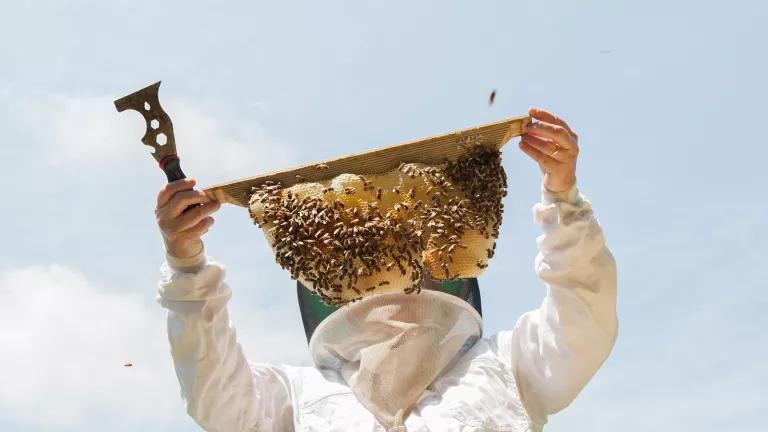A World Without Bees? Here’s What Happens If Bees Go Extinct
Assessing our chances of survival without the prodigious pollinator.

Staff Sgt. Elizabeth Morris/U.S. Air Force
There was more bad news on the honeybee front last week. A U.S. Department of Agriculture report found that honeybee losses in managed colonies—the kind that beekeepers rent out to farmers—hit 42 percent this year.
That number grabbed most of the headlines, but there was more troublesome data below the fold. The magic number in beekeeping is 18.7 percent. Population losses below that level are sustainable; lose any more, though, and the colony is heading toward zero. A startling two-thirds of beekeepers in the USDA survey reported losses above the threshold, suggesting that the pollination industry is in trouble.
For the first time, the USDA reported more losses in summer than winter. Experts can’t explain the reversal—especially since the colony collapse disorder epidemic that peaked several years ago seems to have abated. The summer losses may have a single, unknown cause, or a group of known and intensifying causes, such as pesticides or mites.
Today the White House followed the USDA's report with its long-awaited plan to help maintain and grow the pollinator population, including building pollinator gardens near federal buildings and restoring government-owned lands in ways that support bees. It’s a good first step.
Albert Einstein is sometimes quoted as saying, “If the bee disappears from the surface of the earth, man would have no more than four years to live.” It’s highly unlikely that Einstein said that. For one thing, there’s no evidence of him saying it. For another, the statement is hyperbolic and wrong (and Einstein was rarely wrong). But there is a kernel of truth in the famous misquote.
Bees and Agriculture
Bees and humans have been through a lot together. People began keeping bees as early as 20,000 BCE, according to the late and eminent melittologist Eva Crane. (Yes, someone who studies bees is a melittologist.) To put that length of time into perspective, the average global temperature 22,000 years ago was more than 35 degrees Fahrenheit cooler than today, and ice sheets covered large parts of North America. Beekeeping probably predates the dawn of agriculture, which occurred about 12,000 years ago, and likely made farming possible.
How important are bees to farming today? If you ask 10 reporters that question, you’ll get 11 answers. Some stories say that bees pollinate more than two-thirds of our most important crops, while others say it’s closer to one-third. A spread of that size indicates a lack of authoritative scholarship on the subject. My review of the literature suggests the same.
The most thorough and informative study came back in 2007, when an international team of agricultural scholars reviewed the importance of animal pollinators, including bees, to farming. Their results could encourage both the alarmists and the minimizers in the world of bee observation. The group found that 87 crops worldwide employ animal pollinators, compared to only 28 that can survive without such assistance. Since honeybees are by consensus the most important animal pollinators, those are scary numbers.
Look at the data differently, though, and it's clear why the misattributed Einstein quote is a bit of an exaggeration. Approximately 60 percent of the total volume of food grown worldwide does not require animal pollination. Many staple foods, such as wheat, rice, and corn, are among those 28 crops that require no help from bees. They either self-pollinate or get help from the wind. Those foods make up a tremendous proportion of human calorie intake worldwide.
Even among the 87 crops that use animal pollinators, there are varying degrees of how much the plants need them. Only 13 absolutely require animal pollination, while 30 more are “highly dependent” on it. Production of the remaining crops would likely continue without bees with only slightly lower yields.
OK, So Can We Live Without Bees?
The truth is, if honeybees did disappear for good, humans would probably not go extinct (at least not solely for that reason). But our diets would still suffer tremendously. The variety of foods available would diminish, and the cost of certain products would surge. The California Almond Board, for example, has been campaigning to save bees for years. Without bees and their ilk, the group says, almonds “simply wouldn’t exist.” We’d still have coffee without bees, but it would become expensive and rare. The coffee flower is only open for pollination for three or four days. If no insect happens by in that short window, the plant won’t be pollinated.
There are plenty of other examples: apples, avocados, onions, and several types of berries rely heavily on bees for pollination. The disappearance of honeybees, or even a substantial drop in their population, would make those foods scarce. Humanity would survive—but our dinners would get a lot less interesting.
This story was originally published on May 18, 2015, and has been updated with new information and links.
This NRDC.org story is available for online republication by news media outlets or nonprofits under these conditions: The writer(s) must be credited with a byline; you must note prominently that the story was originally published by NRDC.org and link to the original; the story cannot be edited (beyond simple things such as grammar); you can’t resell the story in any form or grant republishing rights to other outlets; you can’t republish our material wholesale or automatically—you need to select stories individually; you can’t republish the photos or graphics on our site without specific permission; you should drop us a note to let us know when you’ve used one of our stories.
Biodiversity 101
24 Green Projects to Tackle Now
What Would a Monsanto–Bayer Merger Really Grow?